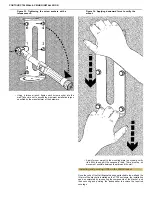
Chapter 4. Installing CT28 on the
Horizontal Mounting Bracket
Critical information
Attention: This wall-mount bracket is intended for installation by
qualified professionals.
Notice: Please read these instructions carefully and completely
before attempting installation.
WARNING
Improper installation or suspension of any heavy load
can result in death or serious injury to persons, as well
as damage to property.
It is the responsibility of the installation personnel to
verify and guaranty the reliability and safety of the
installation.
Notice: This product must be installed in compliance with all
applicable local, state and national regulatory provisions. The
responsibility rests with the installer to verify that the installation
is carried out in accordance with any applicable legislation.
Important: The installer must assess the appropriate stability
and sturdiness of the mounting surface. In the case of wall-mount
and ceiling-mount brackets, this includes, but is not limited to
verifying the positions of suitable studs in the case of drywall
mounts, hollow points in concrete block or solid concrete, as well
as the presence and vicinity of electrical wiring or plumbing.
Restriction: Only hardware and accessories included with
the product or specified by 1 Sound should be used for its
installation.
Restriction: Do not modify or alter the loudspeaker or any
accessory. Any modification by the user or installer could render
the product or the installation unsafe.
Restriction: Do not install a loudspeaker or any accessory near
any open flame or heat source.
Products, accessories and tools required
To install a CT28 enclosure permanently on a wall or surface using the
Horizontal Mounting Bracket, you will need the following:
•
A CT28 loudspeaker enclosure
•
The Horizontal Mounting Bracket kit
•
The Angle Bar kit
•
An appropriate power drill and bit for the installation surface
material
•
A 4 mm hex driver and a 4 mm hex wrench (Allen)
•
Medium-duty mounting screws or bolts appropriate to the
mounting surface (coach screws for drywall studs, concrete
screw anchors for concrete or masonry, etc.); screws and bolts
should have a flanged head or a coupled washer ø14-16 mm in
order to retain the mounting plate
•
Appropriate tools for securing the aforementioned fasteners
(power screwdriver etc.)
•
A torque wrench
•
Optional: a short two-leg steel rope bridle, 2 × M5 double-swivel
hoist rings and appropriate tools for securing these
•
Recommended: pencil or marker, spirit level, stud finder
Procedures
Disassembling the Horizontal Mounting Bracket
The Horizontal Mounting Bracket ships fully assembled, but to facilitate
installation, it should first be separated into three parts: the wall-mount
yoke and the two end plates with the tilt-adjustment mechanism that
attach to the speaker enclosure. Before disassembly, be sure to note the
proper interlocking configuration of the tilt mechanism; this will remove
doubts when it is time to reassemble the bracket.
Figure 48. Removing the M6 bolts from the
Horizontal Mounting Bracket.
Figure 49. Removing the end plates from the wall-
mount yoke.
•
Use a 4 mm hex wrench or hex driver to remove the two M6
bolts from one end of the bracket. Be careful to hold both parts
of the bracket, as the end of the bracket will be free to fall once
the bolts have been removed. Keep these bolts, as the will be
required to reassemble the bracket once it is installed.
Summary of Contents for Contour CT28
Page 1: ...Contour CT28 Wall Ceiling Installation...
Page 50: ......















































